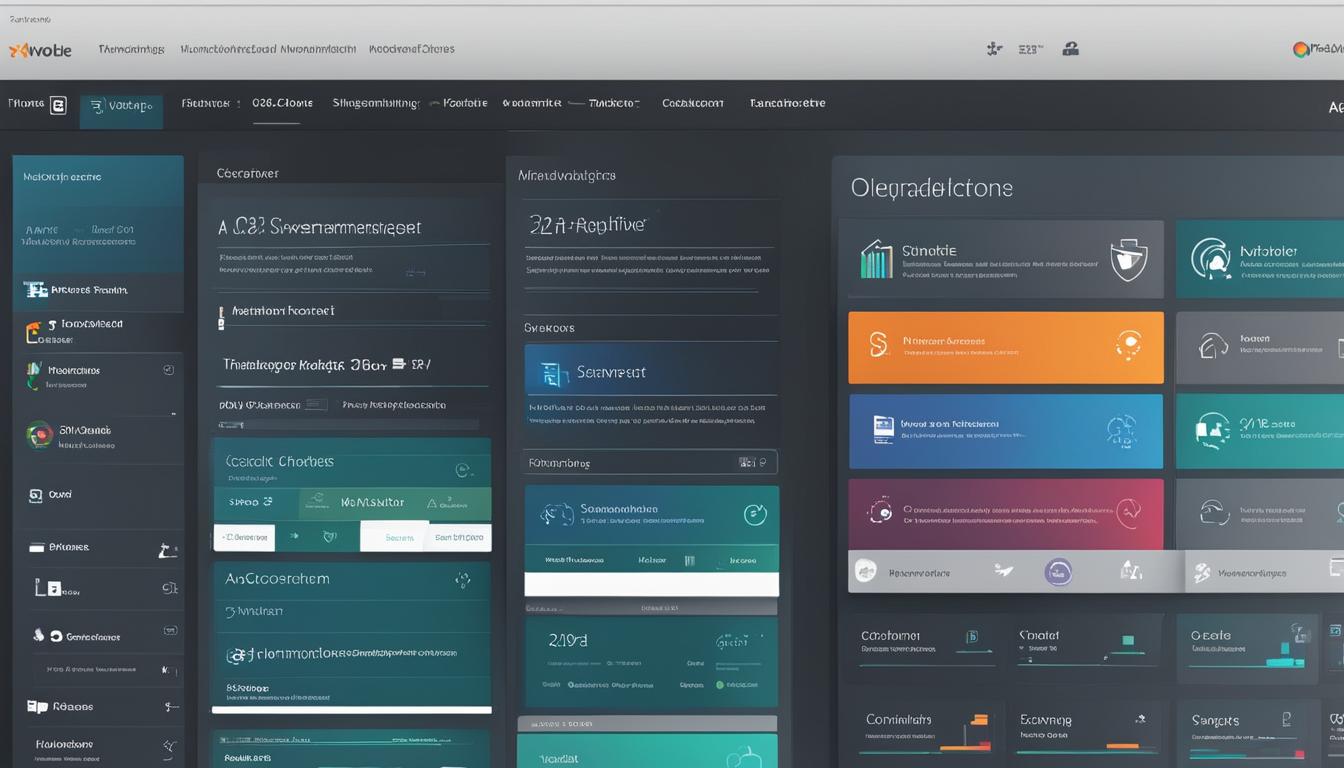In the age of big data and rapidly expanding information, organizations of all sizes are adopting Knowledge Management Software (KMS) to efficiently gather, organize, distribute, and access their collective data. Serving as a digital repository, KMS streamlines knowledge-related processes and improves overall business efficiency. A versatile solution, it is used by various industries and businesses and plays a significant role in managing diverse information resources, including digital asset management, knowledge base software, document management software, and knowledge sharing software.
Key Takeaways
- Knowledge Management Software helps organizations gather, organize, distribute, and access their collective information.
- KMS is a versatile solution for various industries and businesses, including digital asset management, knowledge base software, document management software, and knowledge sharing software.
- Adopting KMS can significantly enhance a company’s operational efficiency and capacity for innovation.
- Ensuring easy accessibility and discoverability of information is a primary challenge in KMS.
- Advanced search functionality, real-time updates, and collaboration tools are essential features to consider when evaluating Knowledge Management Solutions.
- Knowledge Management Software provides organizations with a strategic advantage in the ever-evolving corporate landscape.
The Evolution of Data Management and the Rise of Knowledge Management Software
The transition to the Age of Big Data has revolutionized how organizations handle their information. Cloud technologies have provided seemingly infinite data storage, allowing businesses to accumulate vast amounts of knowledge and data. However, this capability has not solved the essential problem of effectively organizing and searching through this wealth of data. In order to address these challenges, knowledge management systems have emerged as the premier choice for companies looking to improve their data organization and accessibility.
The rise of knowledge management software serves as a direct response to the challenges created by the huge expansion of data accumulation processes. These sophisticated software solutions have been designed to optimize and streamline businesses by providing unified and structured data pools that are easily accessible and navigable. This capability ultimately enhances the efficiency, productivity, and profitability of a business, no matter its size or industry.
Knowledge management systems have evolved from traditional information management software, which served as a simple means of storing and retrieving data. However, these older software solutions lacked the comprehensive functionality required to handle the ever-increasing volume and complexity of data in the modern age. On the other hand, software for knowledge management has integrated advanced features like artificial intelligence (AI), machine learning, and natural language processing. These technologies help expedite search processes, deliver personalized results, and provide users with a more intuitive and user-friendly experience.
Several benefits of adopting a knowledge management system include:
- Enhanced knowledge discovery and sharing within an organization
- Improved collaboration among teams and departments
- Increased efficiency in data retrieval and updating processes
- Reduced risk of knowledge loss
- Empowerment of data-driven decision-making
Companies that recognize the value of establishing an effective knowledge management system are positioning themselves for success in today’s ultra-competitive marketplace. If your organization is seeking a cutting-edge solution to navigate the evolving landscape of knowledge and data management, investing in software for knowledge management is a step in the right direction.
Defining Knowledge Management Software
Knowledge Management Software (KMS) refers to a broad range of solutions that help organizations identify, create, distribute, and organize their collective knowledge and expertise. By adopting a well-rounded knowledge management solution, companies are able to integrate all their resources into a single, unified repository that is easily accessible and discoverable. The primary objective of KMS is to enhance company efficiency and profitability, regardless of the complexities involved in meeting the needs of global and diversified businesses.
At the core of most KMS offerings are cutting-edge knowledge management tools and enterprise search tools that facilitate quick and accurate access to information. These tools enable users to locate relevant data, documents, and other resources with minimal effort, saving time and increasing productivity. As data volumes continue to grow, KMS has become indispensable for organizations looking to stay ahead of the competition.
Implementing a KMS often involves several stages, such as assessing existing information sources, organizing and structuring content, implementing advanced search technologies, and optimizing the user interface for maximum usability. Consequently, choosing the right KMS solution largely depends on an organization’s specific requirements and priorities, which may include factors such as scalability, user-friendliness, and integration with existing systems.
- Identifying: Recognizing and locating valuable information within an organization that should be stored and safeguarded.
- Creating: Generating new knowledge and insights based on existing information or through collaboration with external stakeholders.
- Distributing: Sharing information and insights among team members, departments, or the entire organization while maintaining proper controls and access rights.
- Organizing: Structuring and classifying knowledge in a manner that enables easy retrieval, whether through categorization, tagging, or other taxonomic methods.
In conclusion, the implementation of a comprehensive KMS can significantly improve the overall performance and competitiveness of an organization by centralizing and effectively managing the wealth of information at its disposal. By utilizing knowledge management tools and enterprise search technologies, companies can ensure that their employees have access to the right information at the right time, empowering them to work smarter and more efficiently.
The Advantages of Implementing Knowledge Management Tools
Investing in a knowledge management system can revolutionize the way an organization handles its vital informational assets. Its implementation brings numerous benefits centered around enhancing information flow, collaboration, and data-driven decision-making. In this section, we will delve deeper into these advantages and explore why knowledge sharing software, as well as digital asset management tools, are highly valuable for businesses of all sizes.
Streamlining Information Flow
One of the most significant advantages of adopting knowledge management tools is the ability to streamline information flow within an organization. These tools break down traditional silos that may hinder information accessibility by offering real-time data access from any device and location. This streamlined flow improves efficiency and fosters faster decision-making processes.
Enhancing Collaborative Processes
Collaboration is crucial in any organization, and knowledge sharing software plays a pivotal role in enhancing these collaborative processes. By centralizing and organizing the company’s shared knowledge, these tools help establish a cumulative intelligence environment. As a result, teams can quickly access relevant data and insights to work together on projects and address challenges more effectively.
Empowering Decision-Making with Data-Driven Insights
A knowledge management system not only supports information flow and collaboration but also empowers leaders and decision-makers with data-driven insights. By providing a rich context and factual framework, these tools facilitate complex problem-solving and innovation within organizations. This data-driven approach ultimately leads to better decision-making, ensuring the company thrives and remains competitive in today’s fast-paced business landscape.
Understanding the Core Challenges in Knowledge Management
Despite the numerous benefits offered by knowledge base software, there are key challenges faced in the realm of knowledge management. The primary challenges stem from providing swift access to large data volumes, simplifying the discovery of relevant knowledge, and ensuring that information can be efficiently updated. With the rise of big data and global, interconnected workforces, the process of discovering and accessing critical information has become increasingly complex.
To overcome these challenges, organizations often rely on artificial intelligence (AI), machine learning, and advanced enterprise search capabilities. The integration of these technologies enables companies to tap into the power of AI in knowledge management, improving the efficiency and usefulness of their knowledge management systems.
- Swift Access to Large Data Volumes: With unprecedented amounts of data being produced daily, organizations must have the ability to rapidly access and retrieve information. Knowledge management systems must be capable of handling these vast data volumes and delivering targeted results.
- Discovering Relevant Knowledge: Acquiring pertinent information amidst the sea of data is a taxing task. Enterprise search functionality enables users to search across multiple platforms and formats, pinpointing relevant knowledge within their organizations.
- Efficient Information Updates: Ensuring that knowledge is consistently updated and accurate is a critical aspect of successful knowledge management. By employing AI and automation, these systems can streamline the process of updating information, ensuring that the collective intelligence of an organization remains current and valuable.
In conclusion, it is essential for knowledge management systems to adapt to the dynamic nature of business operations and customer needs. The use of advanced technologies, such as AI, machine learning, and enterprise search, allows for greater efficiency and improved capabilities in knowledge management, effectively addressing the core challenges being faced.
Knowledge Management Software in Action: Use Case Scenarios
Knowledge Management Software is a versatile tool, adaptable for various applications within an organization. It spans across internal documentation to improve in-house operations efficiency, customer self-service portals to enable users with direct access to the knowledge base, and client relationship management, which derives its benefits from centralized data storage for key insights and customer interactions. Let’s take a closer look at these diverse use case scenarios.
Internal Company Documentation
Within organizations, employees often use document management software to streamline the process of creating, editing, and sharing information. By employing a Knowledge Management System, companies can experience enhanced efficiency in managing internal documentation such as training materials, standard operating procedures, and project details. This ultimately enables a smoother knowledge transfer throughout the organization and fosters a culture of collaboration.
Customer Self-Service Portals
Customer support teams can greatly benefit from the integration of Knowledge Management Software with customer self-service portals. By providing users with direct access to the knowledge base, customers can find the necessary information and troubleshoot their issues independently. This not only relieves the pressure on support teams but also leads to increased customer satisfaction as users can quickly find the solutions they need.
Client Relationship Management
Successful client relationship management relies on effective communication and access to relevant information. Integrating a Knowledge Management System along with CRM systems can create a centralized storage for all essential data related to clients, making it easily accessible for team members who interact with customers. By leveraging this streamlined knowledge-sharing process, employees can improve the quality of their customer interactions, leading to stronger relationships and higher client retention rates.
The Technological Backbone: How Knowledge Management Systems Work
Knowledge Management Systems serve as the technological backbone for organizations, enabling the seamless organization and accessibility of valuable information. Employing a knowledge management solution not only streamlines the process of managing vast data volumes but also integrates advanced search functionalities, which are crucial to businesses’ efficiency and productivity.
One of the critical components of these solutions is the advanced search functionality, powered by state-of-the-art artificial intelligence (AI) technology. AI enhances the ability of the system to retrieve relevant information in real-time, customizing results based on user inputs, preferences, and patterns of finding data. This advanced search capability allows companies to pinpoint crucial knowledge swiftly, optimizing decision-making processes and overall organizational efficiency.
Another essential aspect of Knowledge Management Systems is the ability to acknowledge and adopt the varying permissions of applications used within organizations. By doing this, Knowledge Management Systems enables secure and limited access to information based on user permissions, maintaining data privacy, and ensuring compliance with data protection regulations.
To illustrate the intricate workings of a Knowledge Management System, consider the following key elements:
- Centralized Repository: a unifying point where all critical information and data are stored, enabling users to access the desired content effortlessly.
- Scalability: the system’s ability to grow and accommodate increasing volumes of data as the organization expands, without compromising performance or efficiency.
- Collaboration and Real-time Updates: facilitates the sharing of information and insights among team members, allowing them to edit and update data in real-time.
- Content Creation and Management: user-friendly tools and interfaces supporting the establishment and updating of content based on organizational needs and user preferences.
Ultimately, a practical knowledge management solution effectively organizes and manages an organization’s accumulated knowledge, making it easily accessible while ensuring its security and integrity. By adopting such a system, businesses can significantly enhance their decision-making process and overall efficiency, fostering growth and innovation in the face of increasingly complex and data-rich environments.
Who Is Knowledge Management Software For?
Knowledge Management Software is a versatile solution that serves a wide array of users, from small startups to large enterprises. By optimizing knowledge sharing and accessibility, it plays a vital role in enhancing customer satisfaction, streamlining business processes, and promoting collaboration within diverse organizations.
Use by Businesses Small and Large
The applicability of software for knowledge management is vast, touching companies of all sizes within various industries. Small startups benefit from KM software by having an organized knowledge base that supports business growth, while large enterprises rely on the software to manage their extensive data volumes. Ultimately, knowledge management for all businesses is essential for maintaining a competitive edge in the fast-paced corporate world.
The Role in Customer Support and Satisfaction
One crucial aspect of KM software is its contribution to customer experience improvement. By providing streamlined access to company resources for employees, knowledge management systems enable quicker and more accurate customer support in response to queries. As a result, customers enjoy an enhanced experience, urging greater loyalty and overall satisfaction.
Knowledge Sharing Within Diverse Organizations
Within organizations composed of various departments, KM software unifies and structures knowledge, enabling efficient and consistent information exchange. By fostering better collaboration and communication between teams, knowledge management software helps diverse entities make informed decisions and drive continuous business growth.
Integrating Knowledge Management with Other Corporate Systems
Knowledge Management Integration is a crucial aspect for attaining efficient knowledge distribution across an organization. Merging Knowledge Management Software (KMS) with other corporate systems, such as Customer Relationship Management (CRM) software and helpdesk systems, allows companies to maximize the utility of their technology investments and enhance workflow efficiency.
Some typical integrations that enhance an organization’s knowledge management processes include:
- CRM Integration
- Helpdesk Integration
- Project Management Integration
- Collaboration Tool Integration
Below is a summary of the benefits of integrating Knowledge Management Software with CRMs and helpdesks.
| Integration Type | Benefits |
|---|---|
| CRM Integration |
|
| Helpdesk Integration |
|
By incorporating KMS with other corporate systems, organizations can ensure the efficient distribution of knowledge, improve customer service, and facilitate greater collaboration among teams. Integrations also contribute to the seamless flow of information and smooth execution of workflows, ultimately optimizing organizational efficiency and performance.
Digital Asset Management vs. Knowledge Management Software
Organizations face different data management needs when it comes to their digital assets and organizational knowledge repositories. While knowledge management software focuses on the diverse collection of company information and data, Digital Asset Management (DAM) is designed to concentrate on the storage and retrieval of rich media files. This section delves into a comparative analysis of these two software types, illuminating their distinctive features and unique purposes in aiding businesses in managing their digital assets and organizational knowledge.
Comparative Analysis
When comparing Digital Asset Management and knowledge management software, it is crucial to understand their respective features and capabilities. To help differentiate between these two software types, consider the following table, which highlights their primary functions and the areas where they excel.
| Digital Asset Management | Knowledge Management Software | |
|---|---|---|
| Primary Functions |
|
|
| Strengths |
|
|
| Use Cases |
|
|
Understanding the Unique Purposes
While Digital Asset Management is predominantly focused on managing and organizing media files such as images, videos, audio files, and documents, knowledge management software caters to a broader range of data and information within an organization. Both types of software serve critical roles depending on the nature of an organization and the specific data management requirements.
In some cases, companies may benefit from both types of software, particularly if they deal with a significant number of media files and an extensive range of organizational data. In such instances, a comprehensive approach that integrates both DAM and knowledge management software can prove to be highly beneficial in managing their digital assets and informational knowledge repositories effectively.
Top Features to Look for in Knowledge Management Solutions
Identifying the most suitable knowledge management system for an organization can feel overwhelming, especially given the many features and capabilities that various systems possess. However, focusing on some key features can make this decision-making process a bit easier. The following essential features are recommended when evaluating Knowledge Management Solutions:
Advanced Search Functionality
Quick and accurate content retrieval is of paramount importance in a knowledge management system. Leveraging AI-powered advanced search functionality can ensure that users quickly access crucial information when they require it. This helps to minimize time wasted in sifting through irrelevant or outdated information, thus improving workplace efficiency.
Real-time Updates and Collaboration Tools
Staying ahead of ever-changing business landscapes requires a collaborative knowledge software that fosters real-time updates and encourages teamwork. Tools that support a dynamic environment of knowledge-sharing among the workforce enable faster problem-solving and decision-making. This is particularly vital when a diverse team is operating under tight deadlines and needs access to the latest information.
User-Friendly Content Creation and Management
A knowledge management system should have an intuitive interface that makes content creation and management uncomplicated for its users, regardless of their technical proficiency. User-friendly interfaces enable team members to contribute to the organization’s knowledge base seamlessly and maintain the stored information with less effort and hassle.
By considering these top knowledge management features – advanced search functionality, collaborative tools with real-time updates in KM, and user-friendly content creation and management – organizations can sift through the multitude of available solutions to identify one that best suits their specific needs and enhances their operational efficiency.
Conclusion
Adopting knowledge management systems is a vital step in improving organizational efficiency and empowering companies to embrace innovation. By consolidating valuable information resources and facilitating seamless knowledge sharing, these software solutions serve as the backbone for effective and streamlined communication, contributing to unparalleled collaboration and productivity.
Knowledge Management Software caters to a diverse range of businesses, enabling them to leverage a single, unified platform that combines organizational wisdom and accessible data. Furthermore, these systems bolster customer satisfaction by fostering transparent and responsive support environments while enhancing collaboration within organizations.
In today’s ever-evolving corporate landscape, embracing a knowledge management system is an indispensable investment in a company’s future success. As a powerful enabler, it optimizes information flow, offers real-time updates, and nurtures a collective intelligence that ultimately paves the way for strategic growth and competitive advantage.
FAQ
What is Knowledge Management Software?
Knowledge Management Software (KMS) is a digital repository that aids in gathering, organizing, distributing, and accessing a company’s collective information. It streamlines knowledge-related processes and is utilized by various industries and businesses of all sizes.
What are the benefits of implementing Knowledge Management Tools?
Knowledge Management Tools streamline information flow, enhance collaboration between team members, and empower data-driven decision-making by providing a context and factual framework for solving complex problems and fostering innovation.
What are the primary challenges in Knowledge Management?
The main challenges in Knowledge Management include providing quick access to large data volumes, simplifying the discovery of relevant knowledge, and ensuring information can be efficiently updated. Advanced enterprise search and AI technologies can help overcome these challenges.
In what scenarios can Knowledge Management Software be used?
Use cases for Knowledge Management Software include internal company documentation, customer self-service portals that provide users with direct access to the knowledge base, and client relationship management that benefits from centralized data storage for key insights and customer interactions.
How do Knowledge Management Systems work?
Knowledge Management Systems function as the technological backbone, integrating advanced search functionalities powered by AI to ensure real-time retrieval and updating of organizational knowledge. They also manage varying user permissions to ensure secure and limited access to information.
Who uses Knowledge Management Software?
Knowledge Management Software is valuable for a wide array of users, including small startups and large enterprises. It plays a pivotal role in customer satisfaction, enhancing customer support processes, and promotes knowledge sharing and accessibility within diverse organizations.
How does Knowledge Management Software integrate with other corporate systems?
Knowledge Management Software can integrate with other corporate systems such as CRMs and helpdesks, ensuring efficient distribution of knowledge and information and thus maximizing the utility of technology investments and optimizing workflows.
What is the difference between Digital Asset Management and Knowledge Management Software?
While Knowledge Management Software encompasses data management across the organizational spectrum, Digital Asset Management focuses specifically on the storage and retrieval of rich media files. Both systems have distinct features suited to their respective domains and complement each other in providing a comprehensive approach to managing digital assets and informational knowledge within organizations.
What features should be considered when evaluating Knowledge Management Solutions?
Essential features to consider include advanced search functionality powered by AI, real-time updates and collaboration tools, and user-friendly interfaces that facilitate easy content creation and management processes.








